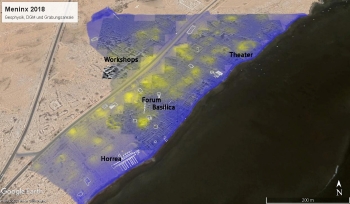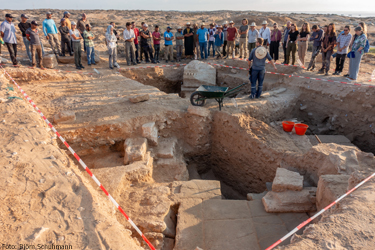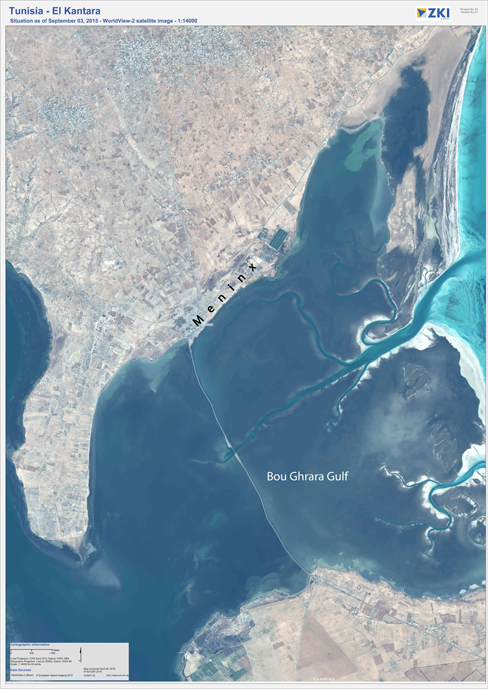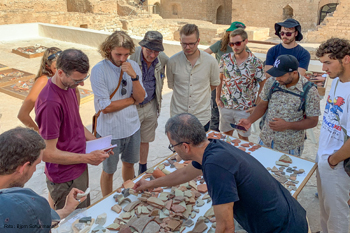Das Meninx-Projekt ab 2023: Ziele (with English summary)
Ziel des Projektes ist es, mittels gezielter Ausgrabungen die frühe Stadtentwicklung von Meninx zu erkunden, vom 4. Jh. v. Chr. bis zu der umfassenden Neugestaltung des Stadtbildes ab flavisch-trajanischer Zeit. Für die Kenntnis der generell noch wenig erforschten vor- und frührömischen Phasen antiker Städte in Nordafrika ist Meninx von exemplarischem Interesse und auch besonders geeignet, da die frühen Befunde hier gut und auf größerer Fläche zugänglich sind.


Die Grabungen sollen in drei Stadtvierteln durchgeführt werden:
1) Von primärem Interesse ist der Bereich um das Forum, unter dem der älteste Siedlungskern liegt. In diesem Bereich sollen in mehreren Grabungsarealen die vor- und frühkaiserzeitlichen Siedlungsbefunde sowie die wachsende Randbebauung des Platzes untersucht werden.
2) Sodann ist geplant, in dem nordöstlichen, erst ab augusteischer Zeit erschlossenen Stadtviertel um das Theater das mutmaßliche Isis-Heiligtum, ein repräsentatives Wohnhaus und eine mögliche zweite öffentliche Platzanlage zu erkunden.
3) Und schließlich soll auch die Geschichte des an der nordwestlichen Peripherie gelegenen Werkstattviertels exemplarisch untersucht werden, um Hinweise darauf zu gewinnen, wann dieses Gebiet erschlossen wurde und ob sich hier, wie zu vermuten, die Werkstätten der Purpurproduktion konzentrierten.
Von diesen Untersuchungen ist Aufschluss darüber zu erwarten, wie man sich die Siedlung in der Gründungsphase vorzustellen hat, wie die Stadt in den folgenden Jahrhunderten expandierte und welche Bereiche sie umfasste, als sie ab dem späten 1. Jh. n. Chr. ihre finale, im Magnetometerbild greifbare Struktur erhielt.


Das in großer Vielfalt zu erwartenden Fundmaterial wird zuallererst detaillierte Einblicke in das Alltags- und Wirtschaftsleben von Meninx und in Veränderungen in den Lebensverhältnissen im Laufe der langen Stadtgeschichte erbringen.
Im regionalen Bezugssystem Tripolitaniens sind darüber hinaus wichtige weiterführende Ergebnisse zu dem engmaschigen mikroregionalen Netzwerk zu erwarten, das neben Djerba auch Siedlungen auf dem gegenüberliegenden Festland umfasste.
Im weiteren mediterranen Kontext schließlich werden die Importfunde genauere Erkenntnisse zu den überseeischen Fernhandelsbeziehungen der Stadt liefern, und zu erhoffen ist schließlich auch Auskunft darüber, inwieweit der Handelsknotenpunkt Meninx in den regen trans-saharischen Handel der tripolitanischen Küstenstädte eingebunden war.
Studies on the early urban history of Meninx
The project aims to explore the early urban development of Meninx through targeted excavations, from the 4th century BC to the comprehensive reorganisation of the townscape that began in the Flavian-Trajan period. Meninx is of exemplary interest for the knowledge of the generally still little researched pre- and early Roman phases of ancient cities in North Africa and is also particularly suitable, as the early features are well accessible here and over a larger area.
The excavations will be carried out in three parts of the city:
1) Of particular interest is the area around the forum, under which the oldest settlement core lies. In this area, several excavation areas will be used to investigate the pre- and early imperial settlement features as well as the growing peripheral buildings of the square.
2) In the north-eastern quarter around the theatre, which was developed from the Augustan period onwards, the presumed Isis sanctuary, a representative residential building, and a possible second public square will be explored.
3) Finally, the history of the workshop quarter on the north-western periphery is to be examined to gain information on when this area was developed and whether, as can be assumed, the workshops for the production of purple were concentrated here.
These investigations are expected to shed light on how one should imagine the settlement in the foundation phase, how the city expanded in the following centuries, and which areas it encompassed when it received its final structure, tangible in the magnetometer image, from the late 1st century AD onwards.
The expected large variety of find material will first and foremost provide detailed insights into the everyday and economic life of Meninx and changes in living conditions in the course of the city's long history.
In the regional reference system of Tripolitania, important further results are expected on the close-meshed micro-regional network which, in addition to Djerba, also included settlements on the opposite mainland.
In the broader Mediterranean context, the import finds will provide more precise insights into the city's overseas long-distance trade relations, and it is hoped that they will also provide information on the extent to which the Meninx trading hub was integrated into the lively trans-Saharan trade of the Tripolitan coastal cities.

